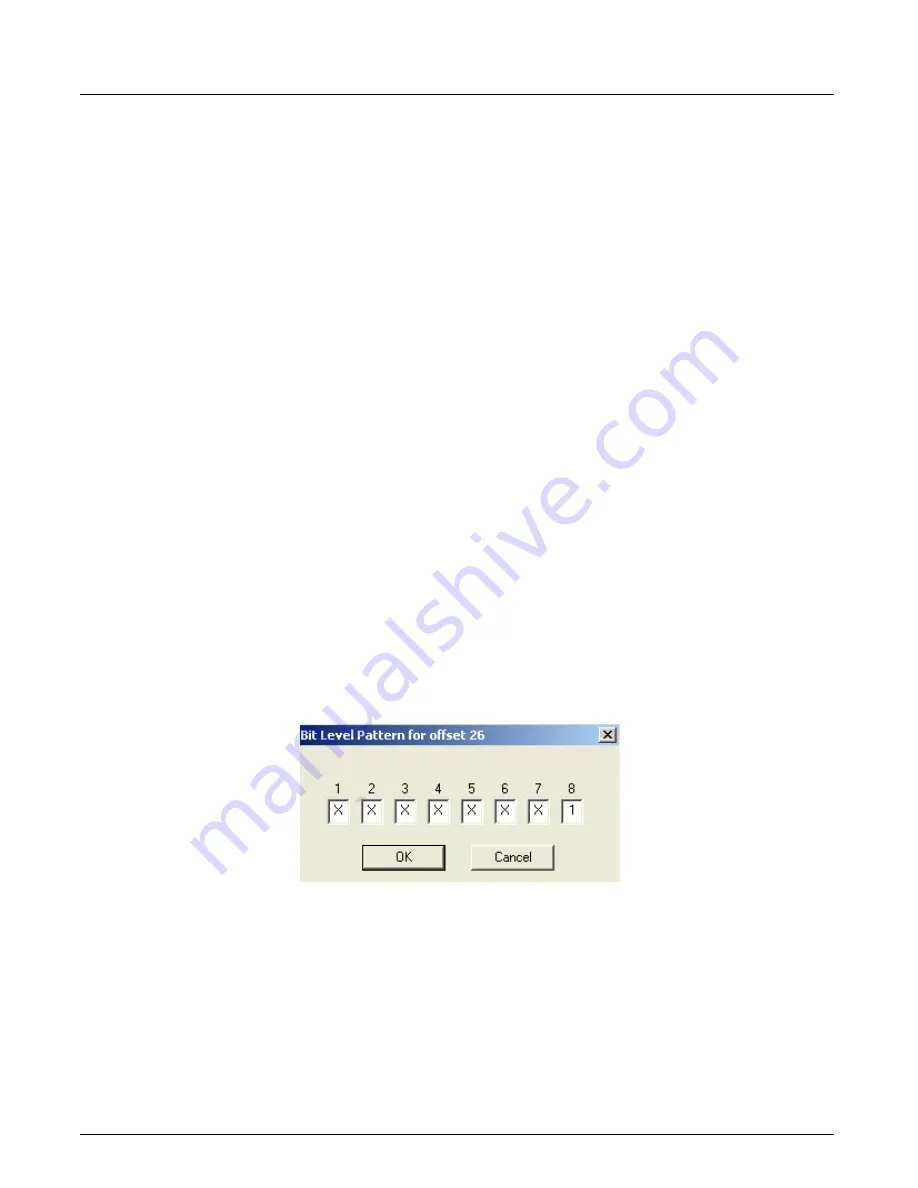
Template Editor
Chapter 5, Template Browser/Template Editor
Xgig Analyzer User’s Guide
153
Entering Values that Cross Byte Boundaries
Port values are generally understood as decimal numbers. For example, an NFS port is known as
decimal 2049. Patterns are expressed as bytes and begin on byte boundaries. It takes two bytes to
express a port number. Therefore, for port numbers you must convert the decimal number to a
value that can be entered on a byte boundary. The example below shows how to enter NFS port
2049 in the display.
1
Take the port number (2049) and divide by 256. The result is 8 remainder 1. In IP “dot”
notation, this could be expressed as “8.1”.
2
Set the Data format pull-down box in the display to Decimal. Values in the Data pattern area
will be entered in decimal.
3
Enter 8 in offset 34 and enter 1 in offset 35. Enter 8 in offset 36 and 1 in offset 37. This sets the
selection to both the source and the destination port.
If a port number is a decimal value less than 256, then the value of the first byte of the port number
is zero, and the second byte is the decimal port number. For example, for HTTP port 80, enter zero
in offset 34 and 80 in offset 35.
The byte-boundary restriction applies to any other decimal number, such as a number in a data
pattern that you want to select for. You must first convert it so the value is expressed using byte
boundaries.
Bit-Level Patterns
Xgig TraceControl can create a pattern at the bit level. To set a bit pattern, place the cursor within
a byte field in the
Current Template Display
area. Press the
Set Bit Pattern
button. The
Bit Level
Pattern
dialog box displays. The dialog box gives the number of the offset you are currently
changing in its title bar. Enter any values for each bit that you want to include in the template.
Leave values that you do not care about marked with an X. An example
Bit-Level Pattern
dialog
box is shown below:
Summary of Contents for Xgig
Page 1: ...Xgig Analyzer Version 7 3 User s Guide ...
Page 2: ......
Page 3: ...Viavi Solutions 1 844 GO VIAVI www viavisolutions com Xgig Analyzer Version 7 3 User s Guide ...
Page 6: ...Xgig Analyzer User s Guide Page iv Version 7 3 December 2015 ...
Page 7: ...v CONTENTS ...
Page 15: ...1 PART ONE Using Xgig Analyzer ...
Page 16: ...PART ONE Using Xgig Analyzer 2 Xgig Analyzer User s Guide ...
Page 27: ...13 PART TWO Using Xgig TraceControl ...
Page 28: ...PART TWO Using Xgig TraceControl 14 Xgig Analyzer User s Guide ...
Page 29: ...15 Chapter 2 About Xgig TraceControl In this chapter Introduction to TraceControl ...
Page 176: ...Chapter 6 Xgig TraceControl Hints and Tips Keyboard Shortcuts 162 Xgig Analyzer User s Guide ...
Page 177: ...163 PART THREE Using Xgig Performance Monitor ...
Page 178: ...PART THREE Using Xgig Performance Monitor 164 Xgig Analyzer User s Guide ...
Page 223: ...209 PART FOUR Using Xgig TraceView ...
Page 224: ...PART FOUR Using Xgig TraceView 210 Xgig Analyzer User s Guide ...
Page 225: ...211 Chapter 11 About Xgig TraceView In this chapter Introducing Xgig TraceView ...
Page 382: ...Chapter 15 Xgig TraceView Histograms Histogram Controls 368 Xgig Analyzer User s Guide ...
Page 383: ...369 Chapter 16 Xgig TraceView Template Editor In this chapter Using Template Editor ...
Page 437: ...423 PART FIVE Using Xgig Expert ...
Page 438: ...PART FIVE Using Xgig Expert 424 Xgig Analyzer User s Guide ...
Page 442: ...Chapter 21 Xgig Expert 428 Xgig Analyzer User s Guide Figure 194 Xgig Expert Graph View ...
Page 443: ...429 PART SIX Appendices ...
Page 444: ...PART SIX Appendices 430 Xgig Analyzer User s Guide ...
Page 454: ...Appendix C Protocol Display Color Coding 440 Xgig Analyzer User s Guide ...
Page 461: ...447 INDEX ...
Page 467: ......






























